'Force Awakens' Had More CG Visual Effects Shots Than 'The Phantom Menace' [Interview]
J.J. Abrams and Disney (smartly) pitched Star Wars: The Force Awakens as a throwback to the original trilogy (the movies that most fans of the franchise loved) and a lot of the behind-the-scenes footage focused on the return to practical effects. But anyone who has seen the movie knows The Force Awakens also has its share of CG visual effects. And this morning, Force Awakens was nominated for Best Visual Effects for this year's Academy Awards.
What might surprise you is that The Force Awakens actually has more visual effects shots than Star Wars: the Phantom Menace. Not only that, while The Phantom Menace had more miniature work than all of the original trilogy films combined, The Force Awakens features not one miniature. But unlike Phantom Menace, a lot of the CG work is invisible. Learn more after the jump.
The fact of the matter is: bad CG in movies is bad not because its the effects were created using computers, but because the effects just weren't executed well. You shouldn't notice great visual effects, be it practical effects or CG. A lot of the computer generated and modified work in The Force Awakens goes by completely unnoticed. For example, did you know there is a scene in The Force Awakens that has Kylo Ren with a completely computer generated helmet? You probably had no idea. I know which scene it is and I still can't tell the helmet was added in post.
When the film does it best, Force Awakens employs a blend of practical effects augmented, extended or replaced by CG vfx. Earlier this week, I got the chance to talk with some of the people behind the visual and practical effects of The Force Awakens to gain some insight into the process. Read my conversation with Patrick Tubach, ILM Visual Effects Supervisor, and Roger Guyett, Visual Effects Supervisor and Second Unit Director.
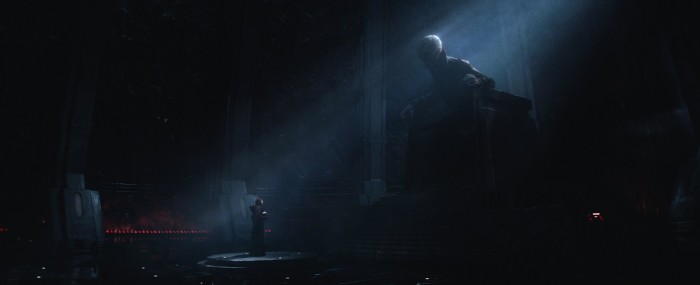 Peter: So Supreme Leader Snoke... He's this huge holographic projection.Roger: Right.Peter: So on his side of it, is he looking at a six inch holographic projection of Kylo Ren and...Roger: (Laughs.) Ah, that's a good question.Peter: 'Cause he's looking down, right?Patrick: That's too yeah.
Peter: So Supreme Leader Snoke... He's this huge holographic projection.Roger: Right.Peter: So on his side of it, is he looking at a six inch holographic projection of Kylo Ren and...Roger: (Laughs.) Ah, that's a good question.Peter: 'Cause he's looking down, right?Patrick: That's too yeah.
Peter: Okay, now seriously, J.J. Abrams sold this movie as kind of being like a return to practical effects and, I mean, I know that that is an aspect of it, but it seems like there's a lot of visual effects.Roger: I noticed, yeah.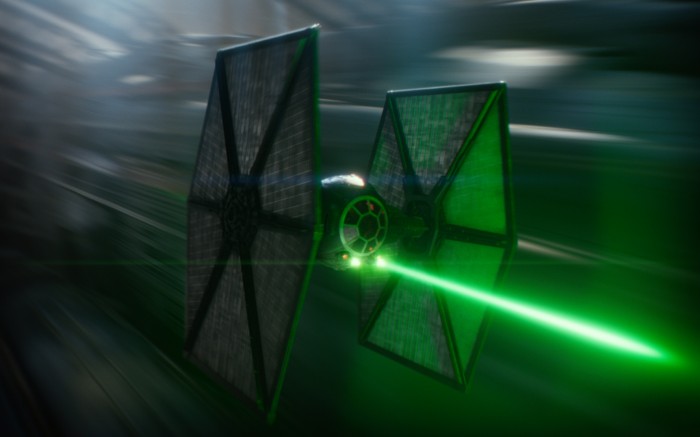 Peter: I think some people might see this marketing and think that there isn't, because a lot of it is kind of invisible. So how many visual effects shots are in this film?Roger: Okay, so there's 2100 odd visual effects shots in the movie. And obviously it's a massive undertaking. But I think what we're trying to do is just do this kind of slight of hand where it's, you know, how you go about doing it, you know, that's interesting on a technical level, but the most interesting thing is that you wanna make a great movie. And for people to believe that all these things are truly happening. And the foundation of some of that clearly is if you can actually shoot some of it in camera and then build from that or maybe you shoot all of it in camera. But for sure, you know, go to these places, go to the locations and have that tangible quality of being at that place, whether it's in the desert or the woods of Puzzlewood [PH] and all these things. But yes, part of our job is to do this massive visual effects movie but make it look as though somehow or another it wasn't that, that wasn't the, you know, there was some other level of reality to it all. But you were, that all of these events were somehow unfolding.Patrick: And I think the dictate was you might as well try to get everything in camera if you can, because it's only gonna help you in the end. And if in the end it's something that isn't successful, we can deal with those. But the fact that you –Roger: We're not trying to ignore modern technology.Patrick: No, the fact that you've done it means that you have a ground truth that you're all aware of from J.J. down the line. We're all aware of what something should look like so we kind of work from there.
Peter: I think some people might see this marketing and think that there isn't, because a lot of it is kind of invisible. So how many visual effects shots are in this film?Roger: Okay, so there's 2100 odd visual effects shots in the movie. And obviously it's a massive undertaking. But I think what we're trying to do is just do this kind of slight of hand where it's, you know, how you go about doing it, you know, that's interesting on a technical level, but the most interesting thing is that you wanna make a great movie. And for people to believe that all these things are truly happening. And the foundation of some of that clearly is if you can actually shoot some of it in camera and then build from that or maybe you shoot all of it in camera. But for sure, you know, go to these places, go to the locations and have that tangible quality of being at that place, whether it's in the desert or the woods of Puzzlewood [PH] and all these things. But yes, part of our job is to do this massive visual effects movie but make it look as though somehow or another it wasn't that, that wasn't the, you know, there was some other level of reality to it all. But you were, that all of these events were somehow unfolding.Patrick: And I think the dictate was you might as well try to get everything in camera if you can, because it's only gonna help you in the end. And if in the end it's something that isn't successful, we can deal with those. But the fact that you –Roger: We're not trying to ignore modern technology.Patrick: No, the fact that you've done it means that you have a ground truth that you're all aware of from J.J. down the line. We're all aware of what something should look like so we kind of work from there.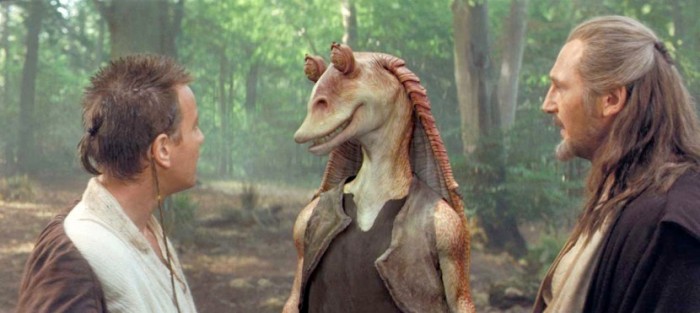 Peter: Yeah. You say 2100 shots... The Phantom Menace had 1900 shots. I think that would surprise people that there's more visual effects.Roger: And it's like one of those things where people are going, it's not a, you should just watch the movie and enjoy it, but it is a tremendous amount of work. It might be more work to actually make it feel like it's less effects shots than The Phantom Menace. You know what I mean? That's the trick. And that's really what I was really interested about the movie was the 12 year old in me was telling me I would love to make it feel like everyone was going on this journey in the movie. And it was more real. It was more, you know, you really believed that all these things were happening. And that there was a more subjective experience to it. And that you were taking this level of reality out to places that you hadn't experienced in Star Wars movies before. And not just that notion, but also we don't want to make a retro movie. We wanna make something with its own kind of forward kind of perspective to it. And at the same time, you know, you want the movie, you know, of course you want the movie to be exciting and have its own level of innovation.
Peter: Yeah. You say 2100 shots... The Phantom Menace had 1900 shots. I think that would surprise people that there's more visual effects.Roger: And it's like one of those things where people are going, it's not a, you should just watch the movie and enjoy it, but it is a tremendous amount of work. It might be more work to actually make it feel like it's less effects shots than The Phantom Menace. You know what I mean? That's the trick. And that's really what I was really interested about the movie was the 12 year old in me was telling me I would love to make it feel like everyone was going on this journey in the movie. And it was more real. It was more, you know, you really believed that all these things were happening. And that there was a more subjective experience to it. And that you were taking this level of reality out to places that you hadn't experienced in Star Wars movies before. And not just that notion, but also we don't want to make a retro movie. We wanna make something with its own kind of forward kind of perspective to it. And at the same time, you know, you want the movie, you know, of course you want the movie to be exciting and have its own level of innovation.
After the jump, continue reading my conversation behind the VFX supervisors on The Force Awakens and learn exactly what effects you believed were practical but were actually CG.
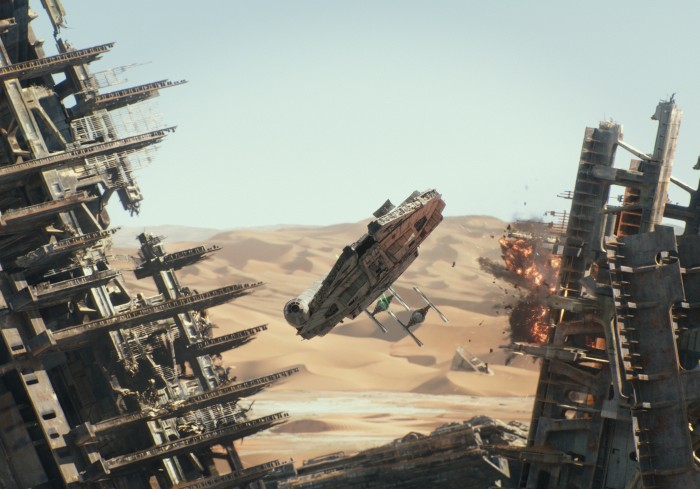 Peter: In the finished film, what is actual practical effect and what is CG? For example, is the desert background in the Millennium Falcon chase real? How many shots of BB-8 are actually real versus...?ROGER: Well the BB-8 is easier to answer. Probably about a quarter of the shots of BB-8 are digital. And we came up with this plan with [creature shop head] Neal [Scanlan]. And that's that kind of collaboration thing where you totally understand what the big pragmatic about what you felt we could achieve with a practical puppet. But the at the heart of that approach was if you have a practical puppet and I have an actor, those two beings can interact. I can puppeteer the thing and the actors can see how the behavior of the puppet and we can totally define that puppet's behavior. Or the droid's behavior. So to us it was so critical to define that so clearly. Then you have other instances where you're going, okay, I'm doing a Falcon chase in the desert. The Falcon's traveling at about 700 miles an hour. I'm gonna create a technology where I can essentially create any version of that desert that I want so I can fly around it and create my own camera moves. And if I can achieve that, then I can essentially put a sequence together like a chase sequence and hopefully people believe that it's all really there, you know, it's all photographed. And the trick there I think sometimes is to base it on somewhere that's real because somehow in your head now you're making that connection that, oh, that's a tangible place.Patrick: Well, and one simple way to put it is after the Falcon takes off, after the depot town, there isn't a single un-manipulated shot after that. They're all CG shots. But there are real elements within them. And that's what I think gives is the real tangible thing, 'cause Roger went up and shot a lot of desert plates in a helicopter and we're using a lot of those plates in there. But they're all some CG version of that. They're –Roger: They're all mashed up.Patrick: Yeah, they're all mashed up in but the cool thing was is to have that real tangible reference. It really makes it feel real and I think it, you still feel the location, even though they aren't just straight plates, you know.
Peter: In the finished film, what is actual practical effect and what is CG? For example, is the desert background in the Millennium Falcon chase real? How many shots of BB-8 are actually real versus...?ROGER: Well the BB-8 is easier to answer. Probably about a quarter of the shots of BB-8 are digital. And we came up with this plan with [creature shop head] Neal [Scanlan]. And that's that kind of collaboration thing where you totally understand what the big pragmatic about what you felt we could achieve with a practical puppet. But the at the heart of that approach was if you have a practical puppet and I have an actor, those two beings can interact. I can puppeteer the thing and the actors can see how the behavior of the puppet and we can totally define that puppet's behavior. Or the droid's behavior. So to us it was so critical to define that so clearly. Then you have other instances where you're going, okay, I'm doing a Falcon chase in the desert. The Falcon's traveling at about 700 miles an hour. I'm gonna create a technology where I can essentially create any version of that desert that I want so I can fly around it and create my own camera moves. And if I can achieve that, then I can essentially put a sequence together like a chase sequence and hopefully people believe that it's all really there, you know, it's all photographed. And the trick there I think sometimes is to base it on somewhere that's real because somehow in your head now you're making that connection that, oh, that's a tangible place.Patrick: Well, and one simple way to put it is after the Falcon takes off, after the depot town, there isn't a single un-manipulated shot after that. They're all CG shots. But there are real elements within them. And that's what I think gives is the real tangible thing, 'cause Roger went up and shot a lot of desert plates in a helicopter and we're using a lot of those plates in there. But they're all some CG version of that. They're –Roger: They're all mashed up.Patrick: Yeah, they're all mashed up in but the cool thing was is to have that real tangible reference. It really makes it feel real and I think it, you still feel the location, even though they aren't just straight plates, you know.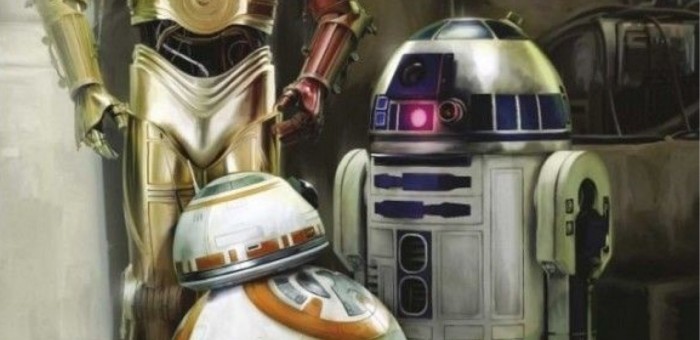 Peter: What is something that is CG in the film that most people would be surprised isn't practical?Roger: Well, I think there are shots, we did a lot of foliage stuff, trees and things like that. I think people would be surprised. One of my favorite scenes for that kind of sleight of hand is more towards the end where we had a scene with C-3PO, R2-D2 and BB-8 and we're literally in some of those shots just for performance reasons, switching between mishmash of real BB-8, CG R2-D2.Patrick: Sometimes the heads are CG, sometimes the bodies are real.Roger: Yeah, Pat and I always joke, we literally sit there going, which one was this the real version of this? And it's partially that that was the motivation. That very idea was the very motivation why we went round this group of having the most charming, in camera kind of approach. I'm using the word charming in a broad sense, but meeting this incredible technology and mashing those two things together. 'Cause the technology available to you today if you have, you know, if you have the right sort of mindset and the right kind of planning and the right kind of restraint, I think it's amazing what you can actually do with that technology. And you're just constantly, you're constantly changing the rules in shots about what's real and what isn't real. There are shots of Stormtroopers in the movie that I defy, I mean –Patrick: There's a good one. When the X-Wings approach and you pan the camera over and the troopers are getting ready to fight off the X-Wings as they approach and you see the X-Wings in the distance, the two troopers that you pan on to at the end of the shot are completely digital. But they are, they just look amazing. And the first time we saw that and the first time J.J. saw that, I remember his reaction was just his mind was just blown.Roger: And what's interesting is I shot that. You know, as second unit director, I did that shot and when I did that shot, I was always like it was a wall. It's the piece that you're traveling up, I mean, it's a classic kind of reveal tracking shot. You're with the guys right through, you track up a wall and that wall was just to give some foreground motion. And at the time, I was going God, I wish we had some ledges on that wall 'cause I could throw a couple of Stormtroopers up there. And you'd reveal up and you'd see these Stormtroopers. And then we come to post-production, I'm going fuck, let's just put some in, you know. And we just started putting in some Stormtroopers. And I was just like holy crap, you know. This actually works. And they look incredible.
Peter: What is something that is CG in the film that most people would be surprised isn't practical?Roger: Well, I think there are shots, we did a lot of foliage stuff, trees and things like that. I think people would be surprised. One of my favorite scenes for that kind of sleight of hand is more towards the end where we had a scene with C-3PO, R2-D2 and BB-8 and we're literally in some of those shots just for performance reasons, switching between mishmash of real BB-8, CG R2-D2.Patrick: Sometimes the heads are CG, sometimes the bodies are real.Roger: Yeah, Pat and I always joke, we literally sit there going, which one was this the real version of this? And it's partially that that was the motivation. That very idea was the very motivation why we went round this group of having the most charming, in camera kind of approach. I'm using the word charming in a broad sense, but meeting this incredible technology and mashing those two things together. 'Cause the technology available to you today if you have, you know, if you have the right sort of mindset and the right kind of planning and the right kind of restraint, I think it's amazing what you can actually do with that technology. And you're just constantly, you're constantly changing the rules in shots about what's real and what isn't real. There are shots of Stormtroopers in the movie that I defy, I mean –Patrick: There's a good one. When the X-Wings approach and you pan the camera over and the troopers are getting ready to fight off the X-Wings as they approach and you see the X-Wings in the distance, the two troopers that you pan on to at the end of the shot are completely digital. But they are, they just look amazing. And the first time we saw that and the first time J.J. saw that, I remember his reaction was just his mind was just blown.Roger: And what's interesting is I shot that. You know, as second unit director, I did that shot and when I did that shot, I was always like it was a wall. It's the piece that you're traveling up, I mean, it's a classic kind of reveal tracking shot. You're with the guys right through, you track up a wall and that wall was just to give some foreground motion. And at the time, I was going God, I wish we had some ledges on that wall 'cause I could throw a couple of Stormtroopers up there. And you'd reveal up and you'd see these Stormtroopers. And then we come to post-production, I'm going fuck, let's just put some in, you know. And we just started putting in some Stormtroopers. And I was just like holy crap, you know. This actually works. And they look incredible.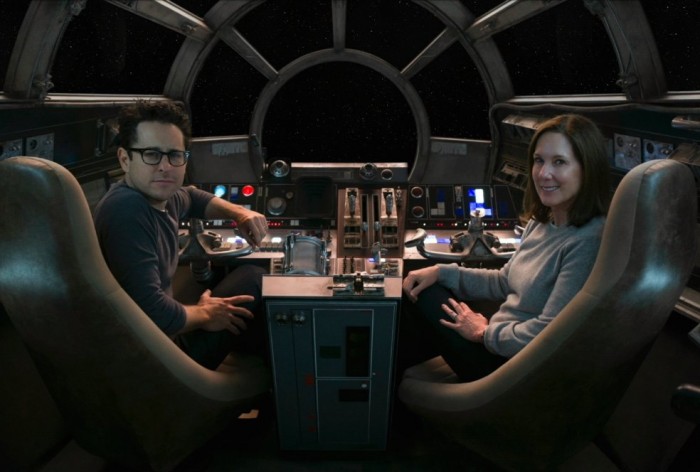 Peter: J.J. Abrams is kind of known behind the scenes to change his mind in the process or to find what he's looking for late in the process. I wonder how does that affect your job, because what you do takes a lot of –Roger: Well I would say that what he does, which I think some filmmakers are more afraid to do, is he's not afraid to change something if he thinks there's a better idea. And that can take all kinds of...Peter: Do you have an example of that?Roger: What would be an example of that in this movie? Well, I'll think about that momentarily, but you can imagine you're down a set path and you're just constantly trying to think of ways to make any of those moments better. And you've got to within the grand scheme of things, you're just trying to figure out whether or not you can achieve that in the amount of time that you have. And the one thing I would say about Star Wars is we were all determined to make it the best movie we could. So I think everyone that signed on for this mission knew that any of us and Pat and I being equally bad offenders, we would always turn to each other and go, what could we do here that would be cooler and more interesting or better? But, I mean, J.J.'s thing really is that he's an incredibly creative man. And part of that is he thinks of good idea. You know, and –Patrick: Yeah, I think he plans things very well, but at the same time he doesn't let himself be constrained by whatever plan he may have had. He sort of lets himself feel it out on the day. And I think one thing we just tried to impart to everybody on our crew is don't get too attached to every single shot or every single idea, because is there is a different version, we're gonna explore that. And I think once people lock into that same mentality, it actually makes you feel a little bit more free to explore your own creativity. And that's what makes him such a great collaborator, because we're constantly, you know, we're able to change things. Instead of being dictated to do something.Roger: Yeah, so you get it, it's kind of like we're sketching out our process, he's reacting to that. I mean, in a movie where you're doing 2100 visual effects shots, you know, there's a certain leap of faith and trust that you –
Peter: J.J. Abrams is kind of known behind the scenes to change his mind in the process or to find what he's looking for late in the process. I wonder how does that affect your job, because what you do takes a lot of –Roger: Well I would say that what he does, which I think some filmmakers are more afraid to do, is he's not afraid to change something if he thinks there's a better idea. And that can take all kinds of...Peter: Do you have an example of that?Roger: What would be an example of that in this movie? Well, I'll think about that momentarily, but you can imagine you're down a set path and you're just constantly trying to think of ways to make any of those moments better. And you've got to within the grand scheme of things, you're just trying to figure out whether or not you can achieve that in the amount of time that you have. And the one thing I would say about Star Wars is we were all determined to make it the best movie we could. So I think everyone that signed on for this mission knew that any of us and Pat and I being equally bad offenders, we would always turn to each other and go, what could we do here that would be cooler and more interesting or better? But, I mean, J.J.'s thing really is that he's an incredibly creative man. And part of that is he thinks of good idea. You know, and –Patrick: Yeah, I think he plans things very well, but at the same time he doesn't let himself be constrained by whatever plan he may have had. He sort of lets himself feel it out on the day. And I think one thing we just tried to impart to everybody on our crew is don't get too attached to every single shot or every single idea, because is there is a different version, we're gonna explore that. And I think once people lock into that same mentality, it actually makes you feel a little bit more free to explore your own creativity. And that's what makes him such a great collaborator, because we're constantly, you know, we're able to change things. Instead of being dictated to do something.Roger: Yeah, so you get it, it's kind of like we're sketching out our process, he's reacting to that. I mean, in a movie where you're doing 2100 visual effects shots, you know, there's a certain leap of faith and trust that you –
After the jump, learn about a scene in The Force Awakens which featured Kylo Ren with an entirely CG helmet, something unnoticed by most fans who have seen the movie, and find out why that came out.
http://i.imgur.com/HMafDss.png
Peter: I've heard there's like a shot of Kylo Ren that had his helmet off and you guys–Roger: Okay, so yeah, that would be a great example of that, is he realized that certain moments between Snoke and Kylo Ren, J.J. went, oh yeah, actually I'm gonna shift the position of that scene. And so that it plays out in a different point in the movie. Now there was a certain point in the movie where he took his helmet off. And now you're taking a scene that was after that and you're putting it before that. And you're going oh shit, he doesn't have his helmet on. And so in a couple of those scenes, the guys in London actually did an incredible job. So when you watch the Kylo Ren –Peter: I've looked for it. I know exactly the scene and I can't even tell.Patrick: Yeah, it's great, yeah. Not only that, he had his helmet under his arm. So we had to fix his arm so you don't see that.Roger: Yeah, so that's the most amazing thing isn't it? About digital technology. You can do that. And that did change the movie for the better, because it changed the focus of –Patrick: It changed his reveal.Roger: So you're kind of going, oh that's interesting. But that's just taking advantage of something that is a modern filmmaking tool, you know.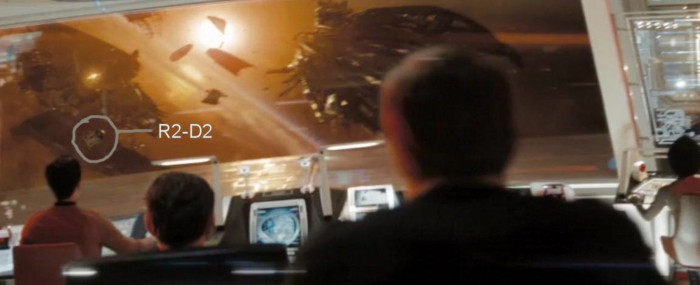 Peter: I'm being told we're wrapping this up, so I have one final question: Is there any Easter eggs that you guys have hidden in the film? I know ILM sometimes puts R2-D2 in a film or is there any kind of –Roger: Well, we have a long history of putting R2-D2 in movies with J.J. I mean, obviously they're in both the Treks and they're in all his movies. But there are many Easter eggs. People are gonna watch this movie over and over again, right? Okay, so to me my thing is, you want it to be such a great level of texture that you can augur in, you can watch this movie multiple times and see things happening at different points in the frame that you may have missed. Pat mentions that the mouse droid, you know –
Peter: I'm being told we're wrapping this up, so I have one final question: Is there any Easter eggs that you guys have hidden in the film? I know ILM sometimes puts R2-D2 in a film or is there any kind of –Roger: Well, we have a long history of putting R2-D2 in movies with J.J. I mean, obviously they're in both the Treks and they're in all his movies. But there are many Easter eggs. People are gonna watch this movie over and over again, right? Okay, so to me my thing is, you want it to be such a great level of texture that you can augur in, you can watch this movie multiple times and see things happening at different points in the frame that you may have missed. Pat mentions that the mouse droid, you know –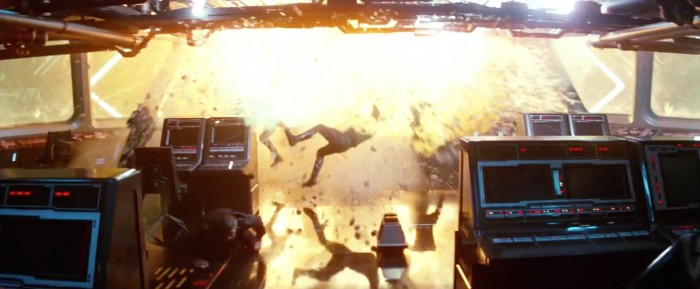 Patrick: There's a mouse droid jumping into a pit at the end of the TIE escape sequence. One thing that we put in that was a fun little detail is when Rey is jumping off the piece of [rope] into the pit in the beginning of the movie where she's going down the rope in the Star Destroyer. We had a little thing there that looked like a little gas cap and so we just said hey, let's just put an Empire logo on that. And it's those little things that people don't notice, but then they go back and they say, oh look at that. And I think those sorts of little details are...Peter: They're fun.Roger: There's many of those, yeah. Many.
Patrick: There's a mouse droid jumping into a pit at the end of the TIE escape sequence. One thing that we put in that was a fun little detail is when Rey is jumping off the piece of [rope] into the pit in the beginning of the movie where she's going down the rope in the Star Destroyer. We had a little thing there that looked like a little gas cap and so we just said hey, let's just put an Empire logo on that. And it's those little things that people don't notice, but then they go back and they say, oh look at that. And I think those sorts of little details are...Peter: They're fun.Roger: There's many of those, yeah. Many.
